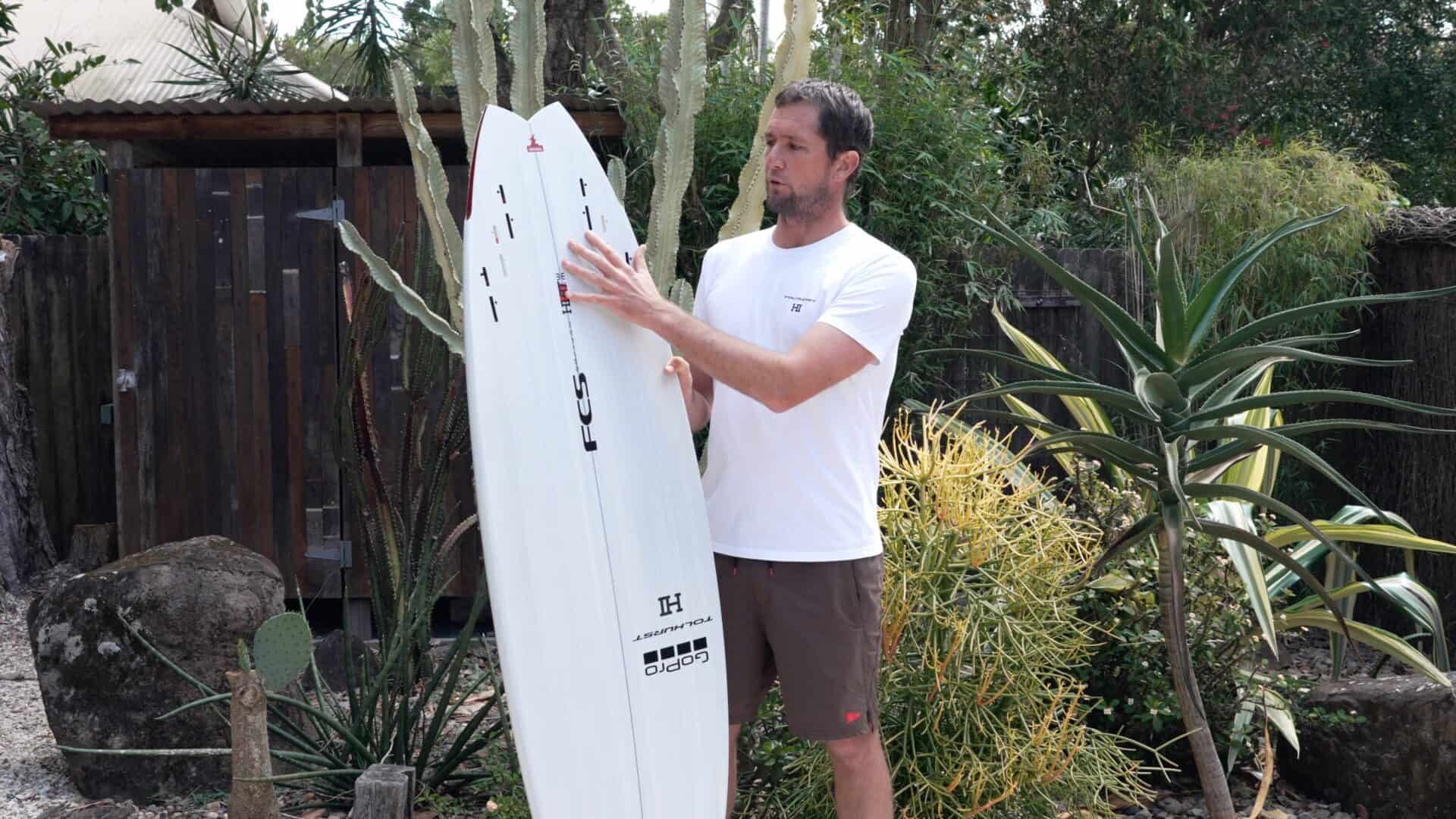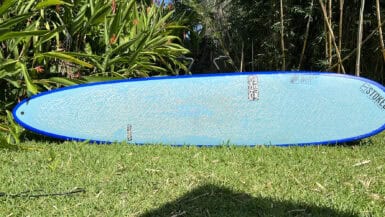I sat down down with surfing legend Harley Ingleby to chat about his new HI BT 3+3 surfboard to figure out if you should add it to your quiver…
When a two-time longboard world champion drops a new surfboard design, the surf world pays attention.
When that surfer is Harley Ingleby—the man behind the world famous MID6—it’s worth paying more than attention. It’s worth considering rearranging the quiver!
This year, Harley and renowned shaper Billy Tolhurst, in partnership with Thunderbolt Surfboards, have released what may be his most versatile performance board yet: the HI BT 3+3.
It’s not just a new outline. It’s not a small tweak. It’s a board that legitimately offers three different fin personalities in one shape, without gimmicks or weird asymmetrical outlines.
In Harley’s words:
“It was years of R&D, endless prototypes, and a lot of time in all kinds of surf. We wanted a board that truly sits between the MOE and the MID6 — more performance, more speed, more range, more fun.”
I’ve been lucky enough to be testing this board out pre-release (yes a full review is coming soon!) and caught up with Harley to chat about his latest design, the theory that went into it and a whole bunch of useful info that will help you decide if you should be grabbing one!
What is the HI BT 3+3?
Contents
At its core, the BT 3+3 is a high-performance fish-inspired surfboard, designed to be ridden in anything from playful beachies to fast, running points. It’s a board that fills a gap Harley identified in his line:
- More performance and release than the MOE
- More small-wave playfulness than the MID6
- Faster and looser than a standard mid-length
- More range and hold than a traditional fish or twin
In short, it’s a go-to travel board and a daily driver for a huge range of surfers.
The name comes from its defining feature: a 3+3 fin plug system that allows the board to be ridden as:
① A True Quad
For speed, drive, and control.
② A True Twin
For looseness, skatey bursts of speed, and flow.
③ An Asymmetric Hybrid
Twin on the toe side, quad on the heel side for a mixed-rail feel.
Harley says:
“Most of what I loved about asymmetrical boards was actually the fin setup—not the strange outlines. With the HI BT 3+3 you get all that versatility without having to reshape or commit to a weird design.”
This is a genuinely R&D-driven evolution of Harley’s earlier experiments with twin asym setups released in 2016.
The R&D: What Went Into the Design
Harley didn’t mince words on this:
“It’s the most R&D we’ve ever done on a board.”
The team tested dozens of combinations of:
- Rocker profiles
- Bottom contours
- Flyer/tail geometry
- Rail volumes
- Fin placements
They wanted a board that could be surfed:
- Short and snappy in tight pockets
- Mid-length style on longer open faces
- With confidence in hollow, punchy surf
The tail uses a sting-style flyer into a deep fish tail, providing:
- Release in turns even on higher-volume sizes
- Rail engagement at speed
- Predictable hold with quad fins engaged
- Smooth transitions between longer and shorter arcs
The overall result is a board that sits at the interesting intersection of:
- Performance shortboard characteristics
Fish-style speed and looseness
Mid-length paddle and glide
Rocker, Foil & Performance Breakdown
The BT3+3 is built for speed that requires very little effort. Harley breaks it down like this:
Nose Rocker
Still performance-oriented — forgiving on late drops, steeper ledges, and critical takeoffs.
Mid Rocker
- Slightly flatter than the MID6 or MOE, resulting in instant acceleration.
Tail + Flyer Design
A sting-style flyer makes the tail break line in a way that keeps larger volumes nimble, especially off the lip.
Rails
- Low and sensitive
- Designed to bite quickly on rail
- Creates confidence in faster or hollow surf
Harley tested the BT 3+3 in everything from beach breaks at home to long Indonesian reefs:
“It’s super fast, super zippy, super loose… I’ve surfed it in hollow, heavier days and it handles it way better than you’d expect.”
Fin Setup Recommendations
Harley shared his exact go-to setups. For surfers who want the same feel he rides, here are the guidelines:
| Configuration | Recommended Fins |
|---|---|
| Quad | His signature FCS2 Mid Quad fins, or Large Reactor fronts + Performer Medium quad rears |
| Twin | Power Twin (a fin Harley created for FCS back in 2016) |
| ASYM | Quad on heel side + Power Twin on toe side |
The quad combo works because of one key detail:
“The Reactor is upright and pivoty, but with a big base for drive. The Performer rears have more rake, great control, and don’t feel tracky.”
Thunderbolt will be releasing a PG quad set specifically recommended for this model.
Size Range & Volume Guide
The BT3+3 has the deepest size run ever in Harley’s line starting at a 5’10 (32L) all the way to 7’2 (50L) with six sizing steps in between.
This range means it can be ridden by:
- First-board beginners
- Returning surfers
- Intermediate cruisers
- Advanced shortboarders
- Proper chargers needing a travel all-rounder
Harley’s sizing notes:
“If you’re between two sizes, go longer. These boards paddle incredibly well, so extra length is only going to help you.”
Sizing Comparing to the MID6
Example:
- 6’4 MID6 ≈ 36L
- 6’2 BT3+3 ≈ 36L but paddles slightly better due to width + flatter entry rocker.
Who Is the BT3+3 For?
Harley sees it working for:
| Skill Level | Why it Works |
|---|---|
| Beginner | Very stable, easy paddle, forgiving entry rocker, especially the longer sizing |
| Intermediate | Thrives in 80% of everyday surf, rapid improvement curve |
| Advanced/Pro | Three-in-one fin tuning, fast release, high performance range, heaps of fun |
He says:
“A pro surfer will froth on this board for travel or day-to-day surf — and a beginner could legitimately use a 7’0 or 7’2 as their first surfboard.”
Ideal Wave Conditions
Harley has put the board through a wide wave spectrum. The recommended sweet spot: is waist high to head high (1–6 ft) but it’s fully capable in a huge range of conditions from knee high playful runners to overhead, fast, bowly waves
Ideal surf includes:
- Punchy beach breaks
- Running point breaks
- Reef waves with pockets
The fish tail, when surfed as a quad, behaves like:
“Two pin tails that bite when you’re flying. It gives you control when you need it.”
Why You Should Add It To Your Quiver
There are plenty of small-wave performance boards on the market, and plenty of modern mid-lengths. But very few boards truly bridge the space between those worlds.
The BT3+3 is:
✔ A one-board travel solution
✔ A daily driver for most conditions
✔ A progression vehicle for intermediates
✔ A play machine for advanced surfers
✔ A gateway board for people curious about asym fins without committing to a strange shape
The simplest summary?
If you surf a lot of good but not perfect waves, this board is designed for your real-world surfing.
Final Thoughts
It’s a concept-driven evolution of years of experimentation, now delivered in a way almost any surfer can benefit from.
Harley’s closing words say it best:
“It’s the most fun I’ve had on a board in a long time… and I’m riding every size in the range.”
Will you be adding the HI BT 3+3 to your quiver?






Leave a reply